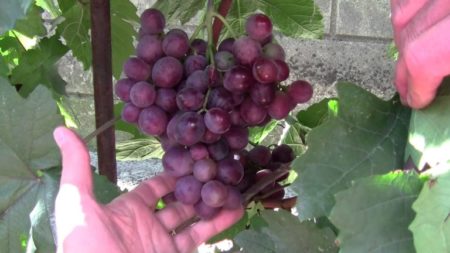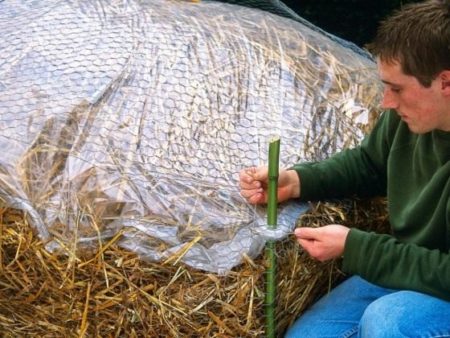Famous grape varieties include Senator. It has been recognized by many gardeners as it bears fruit sweet beautiful berries of an unusual color. There are 2 varieties of Senator: Pavlovsky variety and Burdak variety. To obtain grapes, scientists crossed various subspecies of culture. The final products were similar to each other, so they got one name.
Content
Description of the variety Senator Pavlovsky
Russian scientist crossed 2 subspecies of culture: Gift Zaporozhye and Chocolate. The resulting variety inherited from the parents a beautiful color of complex color fruits. On the berries are purple-chocolate colors with a matte sheen. The skin is durable, does not crack during transportation, therefore grape can be transported over long distances without fear. Berries during maturity reach large sizes, the weight of each grape can be 18-20 g. The fruits are collected in large clusters weighing 1-1.5 kg. The shape of the brush is triangular.
The taste is sweet with a nutmeg. Berries in the mouth melt from a lot of juice. There are seeds in the fruits, but there are only 2-3 of them. Senator Pavlovsky is bred in order to feast on fresh homemade grapes. Berries are suitable for preservation and even freezing. They make wonderful homemade wine or fortified tinctures. Ripening begins in September, as the variety is considered mid-season. From the moment of swelling of the kidneys to fruiting takes 130-40 days. Productivity increases every year and reaches a maximum of 5-6 year planting. In favorable conditions, the figure is 120-150 centners per planting hectare.
Senator Pavlovsky is grown in regions with a temperate and warm climate. Grapes will do for Moscow region, Leningrad region, the Urals. Frost resistance of the variety is at a high level: shoots survive even with frosts of -25 degrees, but with shelter. Fungal and viral diseases rarely affect grapes. There were practically no cases of infection of the variety with oidium and gray rot.
The maximum height of the vine does not exceed 5.5-6 m.
The positive qualities of Senator Pavlovsky are:
- good survival and unpretentious care;
- stable annual yield;
- large berries and brushes;
- good keeping quality and portability;
- universal purpose of the fruit.
The variety has no obvious flaws. In Russia, it is widely gaining popularity, as it has been introduced to the market recently.
Senator Bourdak Variety Characteristics
Another agronomist from Russia named Burdak chose the Talisman and Arcadia grape varieties for selection. For many characteristics, the resulting variety coincides with the subspecies of Pavlovsky, but has several differences:
- ripening period is earlier and makes 110-120 days;
- fruit color is light green;
- the size of the brushes is slightly smaller and amounts to 1 kg;
- the taste of the fruit is more sweet;
- grapes are small in size, round in shape.

Senator Burdak is not inferior to Pavlovsky in immune properties, he is not afraid of fungal spores and viruses. It is possible to grow a variety in any region, regardless of temperature characteristics. Mandatory shelter is needed for the winter, especially in the first and second years of cultivation.
Landing rules
For abundant fruiting in season grape need to be planted correctly. They do this in the spring, not earlier than April, but no later than the onset of summer. For planting, use seedlings with non-blooming buds. The procedure is as follows:- dig holes in the ground with a depth of 1 m, the distance between the pits is at least 2 m;
- a 15-centimeter layer of gravel or any drainage is poured into the pit;
- add a bucket of black soil to each well;
- the roots of the seedling are inserted into the soil, the root neck is not added;
- water the earth with 10-15 liters of water.
When the water completely goes into the ground, the soil is slightly loosened, and then crushed. To preserve moisture in the soil, the soil is mulched with dry sawdust or straw.
Grapes can be grown not only from seedlings, but also seeds.
Care Rules
The senator does not require excessive care and grows almost by itself. There are some nuances to which you should pay attention, otherwise there are no problems. Features of care are:
- not frequent watering. Grapes are well experiencing drought, which can not be said about the waterlogging of the culture. Taste with excess moisture in the soil becomes watery, loses saturation. The number of irrigations per season should not exceed 4 times. During flowering and fruiting, the culture is not watered;
- preventive spring treatment from diseases and pests. It is carried out before the leaves bloom with fungicidal preparations and insecticides;
- timely pruning of vines. The grapes are cut only in the fall, when the fruiting has ceased, and most of the leaves have fallen. Exhausted dry shoots and diseased branches are cut. Leave only a healthy fruiting vine.
Top dressing is carried out when the grapes have already reached maturity 4-5 years. You can use complex additives, they contain a balanced composition of minerals and acidic compounds. The additive is bred and used only according to the instructions. The amount of top dressing is 3-4 times per year.
Shelter for the winter
 Frost is not so much a danger to shoots as to roots. Therefore, when sheltering, the emphasis is on mulching the land. In November, straw is laid on dry soil with a layer of at least 3-4 cm. The vine is removed from the trellis and dug into the straw. On top of the mulch cover grape agrofibre. Now the culture will survive even a harsh winter with temperatures up to -30 degrees.
Frost is not so much a danger to shoots as to roots. Therefore, when sheltering, the emphasis is on mulching the land. In November, straw is laid on dry soil with a layer of at least 3-4 cm. The vine is removed from the trellis and dug into the straw. On top of the mulch cover grape agrofibre. Now the culture will survive even a harsh winter with temperatures up to -30 degrees.
Reviews
According to winegrowers, the varieties are fully consistent with the declared characteristics.
Alena from Perm said:
“I grow Senator Pavlovsky for winemaking, berries are great for fermentation. The grapes survive through winter steadily; not a single vine has frozen. I dig up the shoots and cover the roots with a heap of autumn leaves, and on top I put polycarbonate. "A little shoots are formed in the spring, so only the autumn crop is enough for the grapes."
Ivan says:
“In addition to the Senator, another 2 grape varieties are grown. Berries like the fact that they have a strong skin, do not fall and do not crack. Wasps are indifferent to them, they do not even fly up to the fruit, which can not be said about other varieties. We eat berries from September to October, treat our neighbors and even sell them. ”




 Non-covering winter-hardy grape varieties for Moscow region
Non-covering winter-hardy grape varieties for Moscow region How to keep the vine in winter
How to keep the vine in winter When can I transfer grapes to another place in the fall
When can I transfer grapes to another place in the fall How to cover and prepare grapes for the winter in the suburbs
How to cover and prepare grapes for the winter in the suburbs